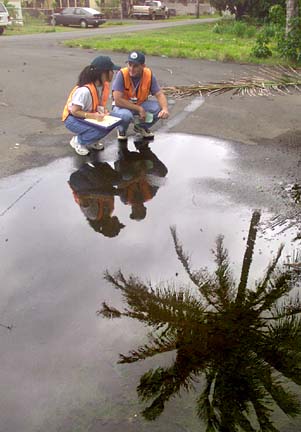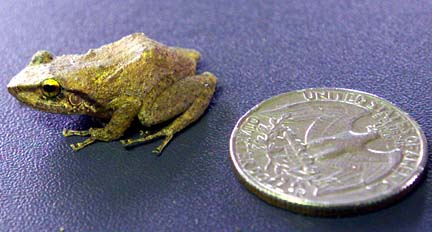


|
227 unemployed About 227 residents who've been unemployed since Sept. 11 are expected to begin working in new jobs tomorrow to help control or rid the state of invasive pests.
since Sept. 11
start pest control
jobs tomorrow
They'll be paid $9.96 per
hour to help rid the state of
invasive plants and animalsBy Helen Altonn
haltonn@starbulletin.comOrganizers of the emergency environmental work force have made a heavy push to start the program so the first paychecks will go out before Christmas, on Dec. 21, said Nelson Sakamoto, human resources director at the Research Corporation of the University of Hawaii.
"To do the hiring this fast, from zero to start to hire in something like two weeks ... it's pretty amazing," said David Duffy, a botanist who leads the UH Pacific Cooperative Studies Unit.
"It's a sentimental and mushy thing, but we thought as many people as possible, we could get them paychecks before Christmas to play Santa Claus."
In the recent special session, the Legislature authorized $1.5 million to give unemployed people work and reduce or eradicate invasive species, including coqui frogs, dengue fever mosquitoes, miconia, fire ants and fire weed. They will work full time for three months for $9.96 per hour.
Some critics have said, "Why not just put money into unemployment?" Duffy said. But the environmental work wouldn't get done and the state would lose the chance to get up to $6 million in matching federal money, he said.

|
Sakamoto said RUCH has been going through nearly 400 applications, with more coming in, to identify workers with any training or experience for the first 227 positions. "If we're lucky, we will be able to employ roughly 250," he said.The first positions tentatively include 85 on the Big Island, 97 on Maui, 33 on Oahu and 12 on Kauai.
"It's exciting but frustrating," said Duffy, whose team is tackling "incredibly complex" logistics involved in getting the emergency workers into pest-plagued areas on four islands.
Maui and Big Island invasive species committees are helping to organize projects that couldn't be done before because of a lack of manpower, he said.
"It's still at an experimental stage," Duffy explained. "We're trying to figure out how you treat or get rid of a lot of these things and keep them from coming back."
He's been calling leaders and landowners on each island trying to figure out how many people are needed, who could handle volunteers and has equipment. The military in some cases and organizations such as the Nature Conservancy are easy to work with because they have experience with volunteers and equipment, he said.

|
But transportation is a problem. "We can rent a bus for three months, or give a person a job, so we're trying desperately to beg, borrow or steal buses and drivers." Protective clothes, boots, gloves and rain gear have been collected for the workers from surplus stores.He said every area will have a project coordinator and generally every 10 workers will have a crew leader. Specialized crews for frogs and ants may have one leader for four people.
For example, teams of two will be sent out at night to listen for frogs. If they detect a big infestation, "we will have to go back later and spray them," he said.
It's the same with fire ants, also known as electric ants because the sting is "sort of like being shot," Duffy said. Peanut butter will be left on chopsticks as bait in areas with identified ant colonies, he said, noting a helicopter may be needed for an infested eight-acre area on the Big Island.
Since the Big Island has no dengue, workers there will start on other projects. About half of Maui's workers will start with mosquitoes, then some may change to miconia, the fast-spreading alien plant that threatens native birds and plants, Duffy said.
He said they're trying to figure out what kind of crew is needed on Maui to attack fire weed, which is pretty, but poisonous and takes over areas.
"You don't want to just annoy this stuff, you want to wipe it out," he said, explaining it may more effective to eradicate small patches than try to attack a big blob of it.
Local control may be used for some species "that are incredibly expensive," he said, such as fountain grass which covers Kona lava fields and burns easily, starting a firestorm.
There's so much of it, Duffy said. "The trick is to nail it where it spreads to new areas, or is in small numbers or threatening historic sites or endangered species. Basically, it provides a lot of fuel. We don't want it to build up near valuable things.
"There are a bunch of species like that either just starting, that we can kill off now before they are a major problem, or they are a major problem and we can kill them in certain areas."